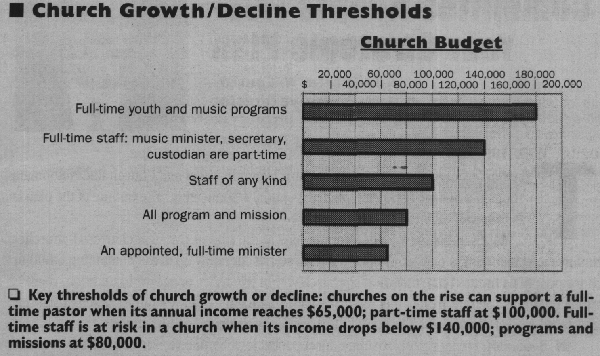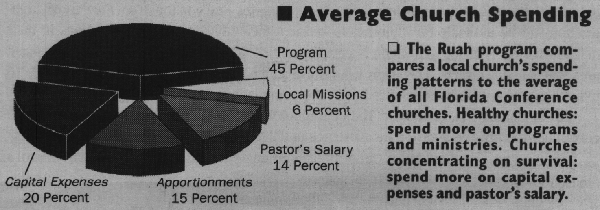General Board of Global
Ministries
![]()
UM Information
![]()
UM Reporter
![]()
Employment
![]()
Archives
![]()
Favorite Places
![]()
![]() Florida Southern College
Florida Southern College
![]()
![]() Bethune Cookman College
Bethune Cookman College
![]()
![]() FL
UM Children's Home
FL
UM Children's Home
![]()
|
|
Technology aims to improve matches |
| By Michael Wacht LAKELAND — The Florida Conference Cabinet met in early March to begin appointing pastors to churches for the next church year, which begins after the annual conference event June 1-5. What makes this year’s efforts unique is that cabinet members are using computer technology to help them make the matches. A newly-created database program called Ruah converts raw data taken from Florida Conference Journals of the past 25 years into charts and graphs, allowing acting Bishop J. Lloyd Knox, the conference’s 14 district superintendents and other cabinet members to see each church’s trends and the impact a pastor has had at previous appointments, according to Orlando District Superintendent Robert Bruce, the cabinet’s liaison to Ruah’s development team. “Ruah gives us the data that helps match a church’s needs and a pastor’s gifts and graces,” he said. “It helps us get a broader picture, but the human element is still there…it’s a heartfelt struggle.” The program was created specifically for the Florida Conference by a team of corporate leaders, educators, computer scientists and theologians. It’s based on research done for a doctoral thesis by the Rev. Dr. Jack Stephenson, pastor of Anona United Methodist Church in Largo and leader of the Ruah project. According to Stephenson, the program looks at information on worship and Sunday school attendance, membership, and the finances of every church in the conference. It can also compile an appointment history for each pastor. What's in a Number? Before this year, appointment discussions were based upon district superintendents’ memories, impressions and personal notes, said Keith Ewing, the bishop’s administrative assistant and a former district superintendent. He said he remembers searching through stacks of paper to find notes on a particular pastor. Now, the decision makers are using computers to access objective data. “As a DS [district superintendent], I can remember taking two, three or four briefcases full of papers to the sessions,” he said. “Now we’re all using laptops.” Ruah is also designed to facilitate conversations between pastors and churches, especially those pastors entering new appointments, according to Stephenson. The local church profiles will offer insight “into what Christ and the Holy Spirit are already doing in a congregation,” Stephenson said. “It [Ruah] will allow pastors and district superintendents to have an insight that wasn’t there before…and to know the story.” The Rev. Jacques Pierre, pastor of Highlands United Methodist Church in Lakeland and a member of the Lakeland District Board of Missions and Church Extension, said he is pleased to know the church is utilizing current technology to help the appointment-making process, but is concerned about leaders relying on it too heavily. “When a pastor is sent to a church, it is the will of God,” he said. “My concern is that it [technology] not replace the prayerful concern and meditation of those in the appointment-making process.” Stephenson says Ruah is only a tool to assist the decision makers. “Human beings will make decisions about where human beings will go to be with human beings,” he said. “Ruah is a real and sincere attempt on the part of the cabinet to consider the needs of the local church in ways they’ve never been able to do before.” Although the 1996 United Methodist Book of Discipline called for improvements to the consultation and appointment-making process, Ewing said the Florida Conference is the only one he knows of working on this type of technology. “It’s exciting to be in on something so cutting-edge,” he said. “It’s one of the areas the Florida Conference is obviously a step ahead of the others.” Ancient word represents modern advancement The name Ruah, or “ruwa`,” is the Hebrew word for the battle cry or shout of joy of the Israelites as they brought down the walls of Jericho (Joshua 6), according to Wigram’s Englishman’s Hebrew and Chaldee Concordance. The name was chosen because the Ruah project signifies the beginning of a transition to a new church model and new ways of doing things, just as the Israelite’s shout marked their transition from the wilderness to the Promised Land. Also, Ruah signifies a cooperation between God and men to accomplish God’s purpose. “It [Ruah] is the shout of the human voice under the direction of God,” Stephenson said. “It asks, ‘What is our part in discerning the will of God?’ ” Top
of this page |


